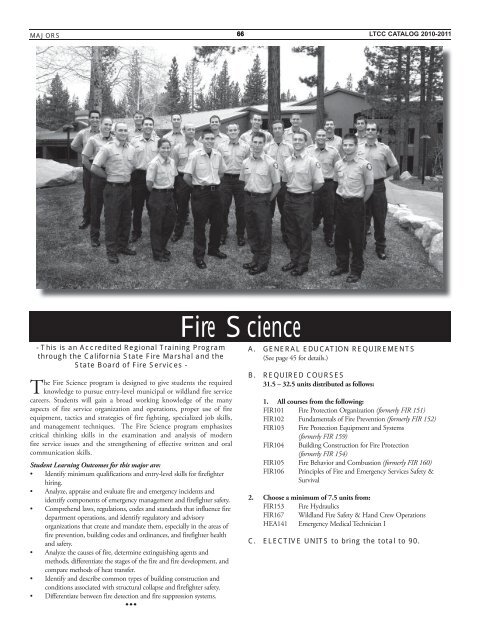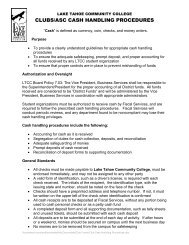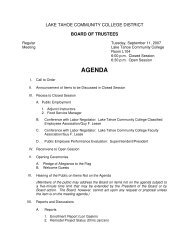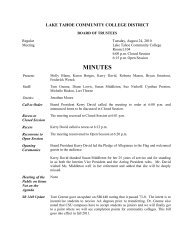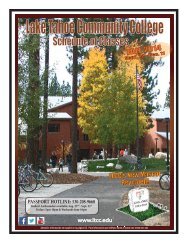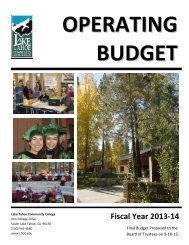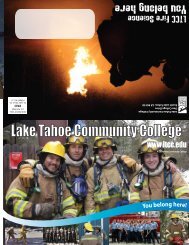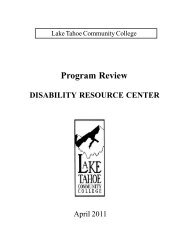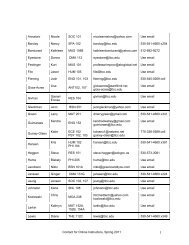- Page 1 and 2:
Lake Tahoe Community CollegeCATALOG
- Page 3:
Mission StatementOur MissionLake Ta
- Page 6 and 7:
LTCC CATALOG 2010-2011 5 WELCOMEand
- Page 8 and 9:
LTCC CATALOG 2010-2011 7 BOARD OF T
- Page 10 and 11:
LTCC CATALOG 2010-2011 9 FOUNDATION
- Page 12 and 13:
LTCC CATALOG 2010-2011 11 ADMISSION
- Page 14 and 15:
LTCC CATALOG 2010-2011 13NONRESIDEN
- Page 16 and 17: LTCC CATALOG 2010-2011 153. Current
- Page 18 and 19: LTCC CATALOG 2010-2011 17 STUDENT S
- Page 20 and 21: LTCC CATALOG 2010-2011 19STUDENT SU
- Page 22 and 23: LTCC CATALOG 2010-2011 21STUDENT SU
- Page 24 and 25: LTCC CATALOG 2010-2011 23 STUDENT L
- Page 26 and 27: LTCC CATALOG 2010-2011 25ALPHA GAMM
- Page 28 and 29: LTCC CATALOG 2010-2011 27 PROGRAMS
- Page 30 and 31: LTCC CATALOG 2010-2011 29SPECIAL PR
- Page 32 and 33: LTCC CATALOG 2010-2011 31POLICIES &
- Page 34 and 35: LTCC CATALOG 2010-2011 33PREREQUISI
- Page 36 and 37: LTCC CATALOG 2010-2011 35POLICY FOR
- Page 38 and 39: LTCC CATALOG 2010-2011 37Student Ri
- Page 40 and 41: LTCC CATALOG 2010-2011 39disciplina
- Page 42 and 43: LTCC CATALOG 2010-2011 41 POLICIES
- Page 44 and 45: LTCC CATALOG 2010-2011 43 DEGREE RE
- Page 46 and 47: LTCC CATALOG 2010-2011 45 DEGREE RE
- Page 48 and 49: LTCC CATALOG 2010-2011 47 DEGREE RE
- Page 50 and 51: LTCC CATALOG 2010-2011 49 DEGREE RE
- Page 52 and 53: LTCC CATALOG 2010-2011 51 DEGREE RE
- Page 54 and 55: LTCC CATALOG 2010-2011 53 DEGREE RE
- Page 56 and 57: LTCC CATALOG 2010-2011 55 MAJORS AN
- Page 58 and 59: LTCC CATALOG 2010-2011 57 MAJORSAdd
- Page 60 and 61: LTCC CATALOG 2010-2011 59 MAJORSArt
- Page 62 and 63: LTCC CATALOG 2010-2011 61 MAJORSCom
- Page 64 and 65: LTCC CATALOG 2010-2011 63 MAJORSCri
- Page 68 and 69: LTCC CATALOG 2010-2011 67 MAJORSThe
- Page 70 and 71: LTCC CATALOG 2010-2011 69MAJORSLibe
- Page 72 and 73: LTCC CATALOG 2010-2011 71MAJORSLibe
- Page 74 and 75: LTCC CATALOG 2010-2011 73 MAJORSNat
- Page 76 and 77: LTCC CATALOG 2010-2011 75 MAJORSThe
- Page 78 and 79: LTCC CATALOG 2010-2011 77 MAJORSThe
- Page 80 and 81: LTCC CATALOG 2010-2011 79 MAJORSVis
- Page 82 and 83: LTCC CATALOG 2010-2011 81 MAJORS4.
- Page 84 and 85: LTCC CATALOG 2010-2011 83CERTIFICAT
- Page 86 and 87: LTCC CATALOG 2010-2011 85CERTIFICAT
- Page 88 and 89: LTCC CATALOG 2010-2011 87CERTIFICAT
- Page 90 and 91: LTCC CATALOG 2010-2011 89CERTIFICAT
- Page 92 and 93: LTCC CATALOG 2010-2011 91CERTIFICAT
- Page 94 and 95: LTCC CATALOG 2010-2011 93 CERTIFICA
- Page 96 and 97: LTCC CATALOG 2010-2011 95SHORT-TERM
- Page 98 and 99: LTCC CATALOG 2010-2011 97 COURSE DE
- Page 100 and 101: LTCC CATALOG 2010-2011 99 ALLIED HE
- Page 102 and 103: LTCC CATALOG 2010-2011 101 ALLIED H
- Page 104 and 105: LTCC CATALOG 2010-2011 103 ANTHROPO
- Page 106 and 107: LTCC CATALOG 2010-2011 105 ARTART 1
- Page 108 and 109: LTCC CATALOG 2010-2011 107 ARTART 2
- Page 110 and 111: LTCC CATALOG 2010-2011 109 ARTART 2
- Page 112 and 113: LTCC CATALOG 2010-2011 111 BIOLOGYB
- Page 114 and 115: LTCC CATALOG 2010-2011 113 BIOLOGY
- Page 116 and 117:
LTCC CATALOG 2010-2011 115 BUSINESS
- Page 118 and 119:
LTCC CATALOG 2010-2011 117 CHEMISTR
- Page 120 and 121:
LTCC CATALOG 2010-2011 119 COMMUNIC
- Page 122 and 123:
LTCC CATALOG 2010-2011 121 COMPUTER
- Page 124 and 125:
LTCC CATALOG 2010-2011 123 COMPUTER
- Page 126 and 127:
LTCC CATALOG 2010-2011 125 COMPUTER
- Page 128 and 129:
LTCC CATALOG 2010-2011 127 CONSTRUC
- Page 130 and 131:
LTCC CATALOG 2010-2011 129 COUNSELI
- Page 132 and 133:
LTCC CATALOG 2010-2011 131 CRIMINAL
- Page 134 and 135:
LTCC CATALOG 2010-2011 133 CULINARY
- Page 136 and 137:
LTCC CATALOG 2010-2011 135 CULINARY
- Page 138 and 139:
LTCC CATALOG 2010-2011 137 DANCEDAN
- Page 140 and 141:
LTCC CATALOG 2010-2011 139 DANCEDAN
- Page 142 and 143:
LTCC CATALOG 2010-2011 141 DMA - EA
- Page 144 and 145:
LTCC CATALOG 2010-2011 143 EARLY CH
- Page 146 and 147:
LTCC CATALOG 2010-2011 145 EDUCATIO
- Page 148 and 149:
LTCC CATALOG 2010-2011 147 ENGLISHE
- Page 150 and 151:
LTCC CATALOG 2010-2011 149 ENGLISHE
- Page 152 and 153:
LTCC CATALOG 2010-2011 151 ESL - EN
- Page 154 and 155:
LTCC CATALOG 2010-2011 153 ETHNIC S
- Page 156 and 157:
LTCC CATALOG 2010-2011 155 FIRE SCI
- Page 158 and 159:
LTCC CATALOG 2010-2011 157 FIRE SCI
- Page 160 and 161:
LTCC CATALOG 2010-2011 159 GENERAL
- Page 162 and 163:
LTCC CATALOG 2010-2011 161 GEOGRAPH
- Page 164 and 165:
LTCC CATALOG 2010-2011 163 GEOLOGY
- Page 166 and 167:
LTCC CATALOG 2010-2011 165 GREEN SU
- Page 168 and 169:
LTCC CATALOG 2010-2011 167 HISTORY
- Page 170 and 171:
LTCC CATALOG 2010-2011 169HOTEL & R
- Page 172 and 173:
LTCC CATALOG 2010-2011 171 ITALIAN
- Page 174 and 175:
LTCC CATALOG 2010-2011 173 JAPANESE
- Page 176 and 177:
LTCC CATALOG 2010-2011 175 MATHEMAT
- Page 178 and 179:
LTCC CATALOG 2010-2011 177 MATHEMAT
- Page 180 and 181:
LTCC CATALOG 2010-2011 179 MEDICAL
- Page 182 and 183:
LTCC CATALOG 2010-2011 181 MUSICMUS
- Page 184 and 185:
LTCC CATALOG 2010-2011 183 MUSICMUS
- Page 186 and 187:
LTCC CATALOG 2010-2011 185 MUSIC -
- Page 189 and 190:
PHYSICAL EDUCATION/FITNESS188LTCC C
- Page 191 and 192:
PHYSICAL EDUCATION/FITNESS190LTCC C
- Page 193 and 194:
PHYSICAL EDUCATION/FITNESS192LTCC C
- Page 195 and 196:
PHYSICAL EDUCATION/FITNESS194LTCC C
- Page 197 and 198:
PHYSICAL EDUCATION/FITNESS - HEALTH
- Page 199 and 200:
PHYSICAL EDUCATION/THEORY - PHYSICA
- Page 201 and 202:
PHYSICS - POLISH - POLITICAL SCIENC
- Page 203 and 204:
PSYCHOLOGY202LTCC CATALOG 2010-2011
- Page 205 and 206:
REAL ESTATE - RELIGION204LTCC CATAL
- Page 207 and 208:
RUSSIAN - SIGN LANGUAGE206LTCC CATA
- Page 209 and 210:
SOCIOLOGY208LTCC CATALOG 2010-2011S
- Page 211 and 212:
SPANISH210LTCC CATALOG 2010-2011SPA
- Page 213 and 214:
SPANISH212LTCC CATALOG 2010-2011SPA
- Page 215 and 216:
INTENSIVE SPANISH SUMMER INSTITUTE2
- Page 217 and 218:
INTENSIVE SPANISH SUMMER INSTITUTE2
- Page 219 and 220:
INTENSIVE SPANISH SUMMER INSTITUTE2
- Page 221 and 222:
THEATRE ARTS220 LTCC CATALOG 2010-2
- Page 223 and 224:
THEATRE ARTS222 LTCC CATALOG 2010-2
- Page 225 and 226:
WILDERNESS EDUCATIONWLD 101 ORIGINS
- Page 227 and 228:
WILDERNESS EDUCATION226 LTCC CATALO
- Page 229 and 230:
WILDERNESS EDUCATION228 LTCC CATALO
- Page 231 and 232:
230 LTCC CATALOG 2010-2011Staff, Fa
- Page 233 and 234:
FACULTY232LTCC CATALOG 2010-2011FAC
- Page 235 and 236:
ABBREVIATIONS & TERMS234LTCC CATALO
- Page 237 and 238:
INDEXIndexAbbreviations and Terms .
- Page 239 and 240:
INDEXGeneral Education Requirements
- Page 241:
240 LTCC CATALOG 2010-2011NOTES


